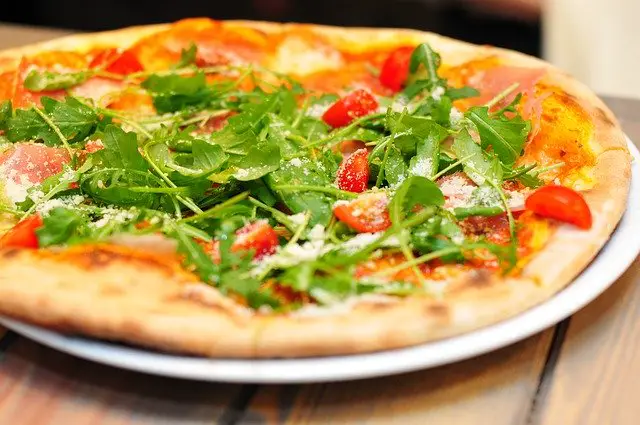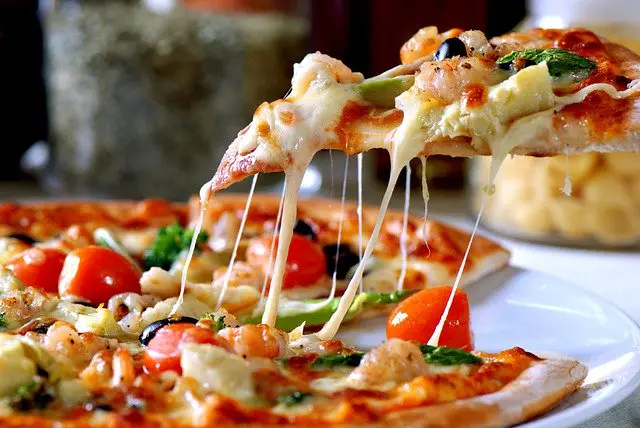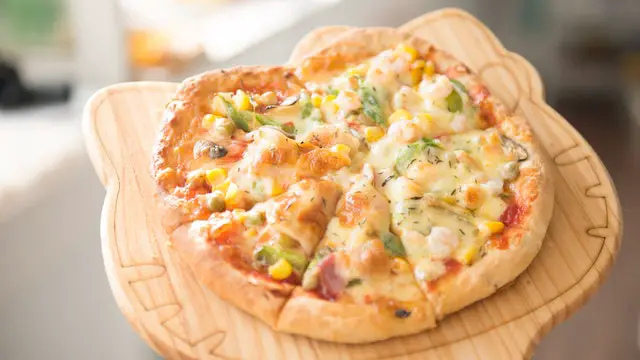This post contains affiliate links. When you buy through our links, we may earn a commission.
Most people like a pizza that is less greasy or not greasy at all. People are very conscious of this issue since they perceive a greasy pizza as unhealthy. What are the tips to make pizza less greasy for yourself, family, or even customers?

You do not have to be pro in the kitchen to make pizza less greasy. It requires you to master essential tips that include using quality meat or cheese with low fat, using thicker crust while making pizza, precooking pepperoni, and use high temperatures for baking. A less greasy pizza can be tasty, tastier than a soggy one.
In our article, we have five remarkable solutions to help you make the best and less greasy pizza. We have also looked into the reasons why the pizza gets greasy. It contains all you need to know about a tasty pizza.
What is the Grease on Pizza?
At times you get a pizza delivery at your door, and it feels good. However, upon opening the box, you might notice grease on top of the pizza, and hence you have to blot it. You are likely to see this behavior in people trying to cut down excess fats in their diets.
What is the grease on a pizza? Usually, it is a result of used ingredients such as pepperoni or other meat products. In this case, after baking a pizza in an oven, the heat expels the fat present in the above ingredients making fats come on the top.
From the above explanation, you will understand that the less the grease culprits used to make pizza, the less greasy pizza you will enjoy. It is the reason why veggie-loaded pizza is less greasy.
What Makes Pizza Greasy?
Does someone intentionally add a separate ingredient in a pizza to make it greasy? No! That is not the case. Scientifically, cheese or meat products used to make pizza contains water molecules, in-between proteins, and fats. Most animal-based products used as ingredients to make pizza will have oils that get out when exposed to heat.
Taking an example of cheese while making pizza in an oven, it gets exposed to high heat levels. The water in the cheese turns into steam that is trapped inside the fats and proteins. As a result, it causes the oils to emit out of the melting cheese and settles on its surface. This process will affect the cheese’s ability to brown. Perhaps, a cheese with low-fat content and high moisture content will easily brown since the moisture will evaporate while cheese with low-moisture and low-fat content is likely to burn. On the other hand, cheese with high moisture and high fats will end up greasy on your pizza. Briefly, the quality is vital if you desire less greasy pizza.
Here is a scientific study conducted by different scholars to help you better understand what makes pizza greasy.
Finally, when you make your pizza using too much heat, it will probably cause the fat in the cheese to melt. You’ll end up eating a greasy pizza.
Why is Pizza Greasy?

There several factors that make a pizza greasy. They include the toppings used, the dough size, and the baking technique.
You can easily notice that a thin crust pizza is very greasy compared to a thicker one. Why? While cooking, a thick crust decelerates the cooking process from the bottom side of the pizza hence allowing the cheese to melt from the top. It’s a ticket to a less greasy pizza. Besides, if your baking technique applies heat from the top and bottom sides, you will get a greasy pizza.
The sauce or toppings used would also cause the greasiness on your pizza. If you cook your sauce with too much oil, it makes the pizza go greasy after it’s exposed to heat. This could probably explain why pepperoni cheese is greasier than mozzarella cheese.
If the kind of meat used is of low quality with high levels of fats, then you should expect your pizza to be greasy. For instance, sausages have higher fat content, unlike beef.
Why is Pepperoni Greasy?
Most of the pepperoni s made from pork or beef or even both. Both have low-fat content; therefore, fats are added to make them tenderer while cooking. Besides, the added fats enhance the flavor of the pepperoni.
The greasiness of pizza made with pepperoni is a result of the presence of high fats content. The grease changes its color to orange due to the ingredients used for seasoning.
What should I do to make a less greasy pepperoni pizza? You should place your pepperoni in a single layer in a wide skillet and turn on medium heat for a minute. Then place it on a paper towel that will absorb the excess oils. Lastly, put them on your pizza for cooking.
Besides, you can try Turkey pepperoni, which is less greasy. It has less fat and has excellent taste.
How to Make Pizza Less Greasy : 5 Awesome Solutions

1. Use Low Fat/Moisture Cheese
The best idea on this is to get quality cheese to make your pizza. You should probably consider low fat /moisture cheese. There are different types of cheese readily available in the market. They are not only low in fat content but also healthy.
An excellent choice is a fresh mozzarella that has less saturated fat and less sodium content. It will help you make a yummy pizza that is less greasy. It comes in different types that include the whole milk mozzarella, reduced-fat, and the part-skim mozzarella. Another better choice is turkey pepperoni.
Similarly, it would be best if you went for that cheese with low moisture content for a less greasy pizza. A good selection that suits this category include the following:
- Provolone
- Low-moisture whole-milk mozzarella
- Fontina
However, using low-fat cheese alters the flavor of your pizza as well as the melting characteristics. On the other side, it will help make pizza less greasy.
2. Bake Pizza at Higher Temperatures
The levels of heat used to bake your pizza and the period it stays on heat are significant factors to consider. Baking pizza at low temperatures will take a longer time to cook while cooking at high temperatures takes less time.
Correspondingly, a pizza baked at high temperatures and very fast is often light and fluffy while that one baked at low temperature and for long is very dense. Would you enjoy a thick crust?
For better understanding, this aspect, try to bake one pizza using a microwave and the other one using an oven. That one from a microwave will be softer and very greasy than the one baked in an oven.
For less greasy pizza, bake at a temperature above 400 degrees to speed up the cooking time. Also, for effectiveness, preheat the pizza pan before placing your ingredients. Also, you may use a pizza stone to help maintain high temperatures.
3. Precook Pepperoni
Are you tired of blotting of those greasy slices of your pizza? Worry no more here is another awesome tip to solve this hassle as you eat your pizza. You can easily do away with excess grease on your pepperoni by using your microwave.
To eliminate the grease, precook your pepperoni in a microwave. Lay all the slices you intend to use on a paper towel and cook for 30 seconds in the microwave. The paper towel absorbs the excess grease, but you can still dry it further by using a napkin or another paper towel.
You must not use the microwave if you want a little bit of crispness and crunchiness. Heat a skillet at medium heat and place your pepperoni pieces—Cook for a minute to eliminate some of the greases. Then place them on a paper towel or napkin to soak up the grease.
It would help if you did not overcook your pepperoni pieces since they will still be baked as part of the pizza.
4. Use a Thicker Crust
It’s always a good idea to use a thick crust if you want a less greasy. The thick crust will easily suit you if you are using greasy toppings.
Thin crust easily absorbs much of the grease hence making the end product very greasy. If you are using a thin crust, you should use little toppings. Try to eat a pizza from a New York Style Pizza and compare it to a piece of Detroit-Style Pizza to see the difference. The Detroit-style pizza is fluffy, crispy, delicious, and less greasy, while the New York Style pizza less crispy and greasy.
The thicker the crust, the more it absorbs the grease and vice versa.
5. Serve Pizza on Clean Surface
Serving your pizza on the same pan you baked on will make it greasy. Why is this a mistake? All the grease that melted while cooking will remain on the bottom of the pizza. It will look messy.
To avoid such a problem, always transfer your cooked pizza on a different clean pan or a clean and dry cutting board. The board will make it easy to slice the pizza. It would also help if you let the pizza cool off for a few minutes as it thickens the oils; therefore, you will enjoy a less greasy pizza.
Is Greasy Pizza Bad for You?

Pizzas are very delicious, and one-piece is never enough. Some people say that “pizza is like the entire food pyramid.” However, too much grease on your pizza might be unhealthy for your body. Do you know that October 25th is National Greasy Foods Day?
Excess grease on your pizza might cause more harm than good to your health. Let’s look into some of the effects of greasy pizza.
- Greasy may contribute to your acne problem
- Raises a risk for heart diseases and Type 2 diabetes
- It strains the digestive system. Most of the grease is fats and oils which are not easily digestible when consumed; hence you might experience bloating, discomfort, and nausea.
However, not all greasy content on your pizza is bad. Some of the greases help you maintain healthy skin, hair, and nails. Besides, every piece of pizza always contains grease, even if it is in small quantities.
Conclusion
Nobody wants to eat a messy pizza with all the grease all over. Did you learn how to make pizza less greasy?
Less greasy pizza is always tasty and even gives one confidence while eating. Besides, it does not have many oils; hence it not bad for your health. To achieve such results, observe the above discussed five tips that range from quality ingredients, high temps while cooking, thick crust to serving your yummy pizza on clean surfaces.
Enjoy.
